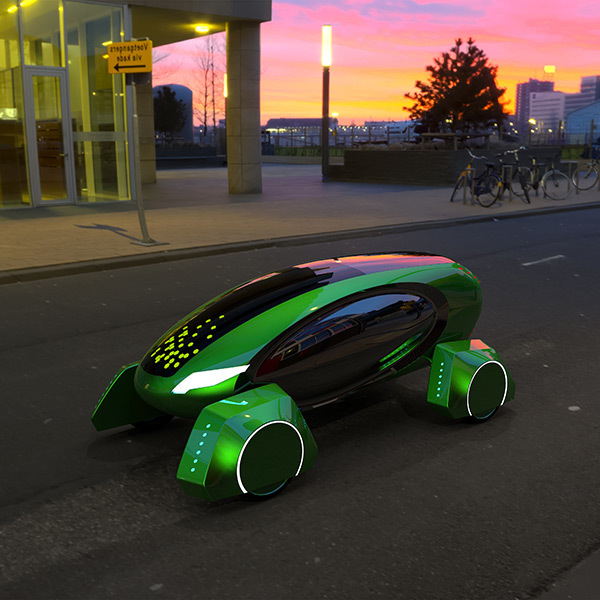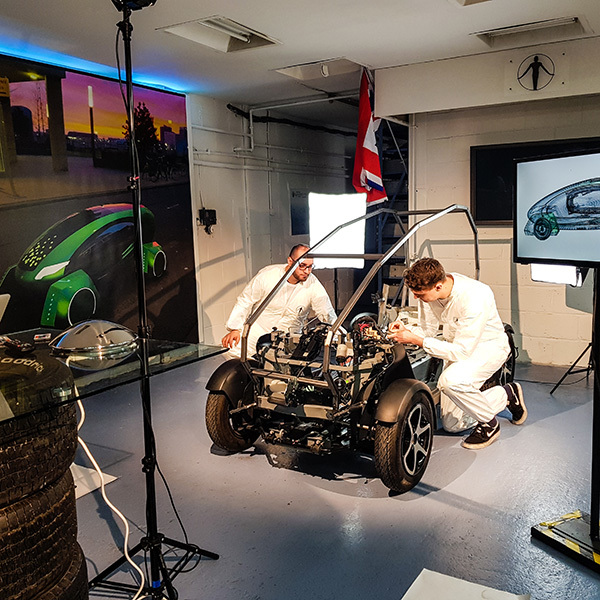E-Commerce
Driverless Disruption: The Self-Driving Vehicles Set to Transform Product Deliveries
With driverless vehicles becoming increasingly sophisticated, the delivery industry is poised for significant disruption. Lucy Ingham hears from Academy of Robotics founder and CEO William Sachiti about how the technology is set to significantly cut costs and transform the customer experience
A decade or two ago, when the internet was gaining mainstream popularity, there was a fear that it would mean the death of mail carriers. The UK’s Royal Mail was so concerned by this trend that it even ran adverts featuring legendary performer Elton John, reminding people that the internet couldn’t bring real-world objects to their homes.

William Sachiti, CEO,
Academy of Robotics
But the organisation needn’t have worried. While letters are waning, the rise of e-commerce has led to a delivery boom, meaning everyone from individuals to businesses are getting purchases delivered to their homes.
This has led to a host of delivery-focused start-ups, many of them using the Uber model to provide affordable services to businesses. However, it remains an expensive setup, particularly for low-cost items. And while Amazon has cracked that area simply by sheer scale, other businesses, from SMEs right up to major corporations, still struggle to compete.
Now, however, there may be a solution on the horizon. While drones are often mentioned as a solution to the so-called last mile delivery problem, a number of companies are exploring driverless delivery, which promises to arrive faster, cheaper and with fewer barriers along the way.
“Driverless vehicles as a solution are coming thick and fast, faster than people know,” explains Academy of Robotics founder and CEO William Sachiti. “I think maybe in three to five years it will be quite normal to see most cars with heavy automation, and driverless delivery is just that next step. In fact, it probably will come first.”
The first trials of such driverless delivery vehicles have, in fact, already happened. In June, the borough of Greenwich in London, UK, hosted a trial of an autonomous grocery delivery van, developed by driverless car company Oxbotica. The result of a partnership with online grocery giant Ocado and driverless vehicle research initiative GATEway, it saw groceries briefly delivered to UK homes by a self-driving vehicle.
However, the Academy of Robotics has its own, arguably far loftier, plans, and next year it will begin the first customer-involved trials of its autonomous delivery vehicle, Kar-Go.
Kar-Go: tomorrow’s delivery service?
The latest project by Sachiti, whose previous successes include solar powered digital advertising bins Clever Bins and digital concierge company MyCityVenue, Kar-Go is the realisation of his long-held dream to use technology to disrupt delivery.
And for a customer, the service will be a familiarly technology-infused experience.
“What we're working on now is much like your Uber app; you can see on an app on your phone a map of where you are and where your car is,” he explains. “You can see it literally pull up outside, maybe right in your driveway: the closest place it can pull up.”
The car itself is a highly futuristic vehicle sporting sophisticated AI and an electric engine, with an appearance reminiscent of a metallic dragon. However the customer interaction is designed to be as simple as possible.
“You simply go up to the car – it knows you through proximity of your phone - you press one button and it just opens up,” he says. “When it opens up, it only gives you your package, and inside is a clever revolving mechanism where it knows to select your package and not, maybe, your neighbours. So the car can do multiple deliveries at once, one after the other, in any order based on who's available at the time.”
“The car can do multiple deliveries at once, one after the other, in any order based on who's available at the time.”
Initially launched at the University of Aberystwyth, the Academy of Robotics has already attracted considerable investment for Kar-Go. An equity crowdfunding campaign on Crowdcube attracted £321,000 of funding, which is being matched by an investment from a currently unnamed organisation Sachiti says is one of the world’s largest tech companies.
With that funding in place, a team of engineers based in Small Dole, a West Sussex village located near the coastal city of Brighton, UK, is now building the final design, to create a road-legal driverless vehicle that will next year be undertaking its first deliveries as part of formal trials.
“We've essentially started building the final version of the car to hit the streets in about maybe five or six months, maybe a bit sooner,” explains Sachiti. “We're probably going to do official tests after a few months, where we test it ourselves on private land.
“Everything should work, but when you've got a new configuration there's a bit of tinkering to do to make sure everything is working as it should.”
From there, it will only be a matter of years before a full rollout of the service can occur.
“We think within three years this will be a standard. Our plan is to do a couple of trials in Europe and Asia simultaneously, and then in approximately 18 months from today we'll raise what we call our series A, which is bigger funding, which allows us to build several hundred units at once and then start scaling,” he says.
“These might still class as trial units, but still they'll be doing live deliveries to live customers here in the UK.”

Driverless delivery: the business case
The reason that Sachiti can be so optimistic about Kar-Go’s prospects is that vehicles like his offer an incredibly good business case: it finally allows retailers to compete with the giant that is Amazon on low-price orders.
“With most retailers there's a sort of magic number, which is around the £25 and below mark. What happens with this number is that when, let's say for example a person buys a bunch of razor blades and the order value comes up to let's say £12, if you go for standard package delivery, I think even Royal Mail doing the cheapest is about £6, £7,” he explains. “So that's up to 30-40% of the order value being just delivery.
“What happens is consumers would rather go to somewhere like Amazon who will deliver you all this for free; they'll deliver it for free because the huge scale of economics just absorbs their cost. But these smaller retailers – who are still huge: I'm talking billions in turnover – they can't match this sort of next-to-no-cost delivery all the time.
“So they're losing a lot of business, because for anything under £25, people would rather just go to Amazon who'll deliver it next day for free, and they can't match that.”
“For anything under £25, people would rather just go to Amazon who'll deliver it next day for free, and other companies can't match that.”
On sub-£25 orders, driverless vehicles offer an unrivalled solution for retailers, from SMEs up to major corporations.
“We're able to give them a solution where they finally can offer really low-cost delivery, where it is worth it for someone to go to the big-name retailer to buy something for under £30 because it will be delivered without them having to pay £7-8 or 20-30%, or even up to 40%, on top of their order value just for delivery.”
Quantifying precisely how much businesses will be likely to save is challenging with so many variables, but it’s clear that it is significantly cheaper.
“When you have a delivery van and you're a van driver, there's a cost of leasing that van, which will cost maybe £400-500 a week, and then there's the cost of labour, you have to pay the driver. With us, you pay a driver nothing, so the human cost is gone completely,” explains Sachiti. “And if you know the going market rate for a driver, a single car could take off £20,000-£30,000 just by switching to some of ours, just in labour only.
“Before you've gone to no-cost fuel, before you're gone to things like that our vehicle is significantly cheaper than a van anyway, so the savings are huge when you start multiplying multiples of several hundred or several thousand vehicles.”
The drone in the room
The elephant in the room when talking about driverless delivery vehicles is, of course, drones. For many consumers, drones are seen as the solution to on-demand delivery, thanks for the most part due to an extensive campaign by Amazon and its Prime Air delivery drone concept.
Sachiti, too, initially thought this was the solution, and when he initially set about disrupting the sector six years ago, drones were his starting point.
“How comfortable are you with a really, really, really loud sound of a drone outside your window five, six times a day doing your deliveries down your street?”
“I filed a patent for something called a sky highway. This was to be an invisible road network in the sky that drones would be able to use to navigate from point A to point B, specifically for deliveries. I thought drone deliveries could work, but we'd need some sort of system on the road, the road network, so why don't we build in the sky?”
However, as Sachiti delved further into the concept – even taking a degree in AI and robotics to, as he puts it, “up my geek credentials”, it became clear that there were major barriers to drone delivery, which are a long way from being resolved.
“Their biggest problem is social acceptance. If you think about it carefully, how comfortable are you with a really, really, really loud sound of a drone outside your window five, six times a day doing your deliveries down your street? And this thing is loud; it’s louder than a car revving its engine; it’s like a washing machine at full tilt pretty much several times a day. We don't believe that people would be comfortable with that.”
However, the case is not just financial. Driverless vehicles also have the potential to offer an improved customer experience, a world away from the frustration of ‘sorry you were out’ cards and packages chucked over garden walls.
“With us you'll never have that card saying 'sorry you were out' again,” asserts Sachiti. “Imagine your Uber app, where you can see where your vehicle is, because it's coming to you: we can technically do the same thing with the delivery now where it won’t come if you're not home or it'll only come when you want it to come.
“It’s on-demand delivery at its finest where it doesn't matter what time of the day it is: if you order and there's someone to send it at 3am, if you're happy for it to turn up at 3am it will, because it’s just a robot - there's no one there.”
Across the UK and beyond
It seems that taking the decision to eschew the fashionable for the practical has worked for the Academy of Robotics, as Kar-Go is already attracting serious interest from a number of quarters.
Sachiti has been in serious discussion with several of Europe’s fast-moving consumer goods (FMCG) brands, and there is likely to be an announcement relating to this before long.
“One of our investors we're finalising papers with is a very big technology company not based in Europe.”
Similarly, a soon-to-be-announced technology partner looks set to aid trials outside of Europe, allowing the company to rollout its offering internationally in fairly short order.
“One of our investors we're finalising papers with is a very big technology company not based in Europe,” says Sachiti, coyly. “They're quite a big household name and in their home country they're quite interested in trialling that at the same time there, so we can be doing it from two fronts. Once I have more information on that I will be able to share, but, for now, not quite yet.”
Convincing the public: the real barrier to driverless adoption
Many assume that regulatory issues are the biggest barrier to driverless vehicles, but – at least for testing purposes – the Academy of Robotics’ final iteration of Kar-Go will be fully compliant with the UK’s Department of Transport regulations.
However, while retailers and other large brands look likely to embrace the concept of driverless delivery, consumer acceptance remains the single most important issue that stands between Kar-Go and success.
“How comfortable will people be with an autonomous car doing deliveries? We think they will be, that's why we went for that rather than drones, but I think the biggest hurdle with any new tech is people liking it,” explains Sachiti.
“If you can please kids and grandma, then you've won, and that's kind of the direction we're going for.”
“Just think of Google Glass: Google released this amazing product, but nobody seemed to like it. They're great technology, but I think the public's perception can perhaps be the biggest hazard with any tech like this.”
However, the Academy of Robotics has taken considerable steps to design the vehicle in a way that will encourage the public to react positively to it, a move which could prove to be the difference between success and failure.
“If you've seen our vehicle, others call it the alien car or they call it little Toothless - it looks like a baby dragon, they say,” explains Sachiti.
“They say kids are the harshest critics, so I decided we should go down the route where if it pulls up to a residential street, kids should be excited to see it, they should want to take a photo of it and think 'oh my gosh, it’s amazing'. If you can please kids and grandma, then you've won, and that's kind of the direction we're going for.
“So it should be friendly yet exciting, it should be a positive experience. That's why we didn't want to go for the traditional route, we thought lets really stand up.”

A world changer or a job killer?
Of course, with any automation comes the fear of job loss, and it is undeniable that Kar-Go is a threat to delivery drivers’ employment. However, Sachiti is keen to stress that it may also prompt the generation of whole new areas of employment, just as disruptive technologies did before it.
“1846 London was a city of horses and carts, and this new technology came up called the self-propelled vehicle, and people freaked out saying it’s going to get rid of jobs; think of all the people who do horse shoes, all the stables, all these horses out of a job, and it was predicted to be a disaster,” he says. “But years later its one of the biggest industries, employs so many people, new jobs came to be and I think we all agree we're better off having cars than we are having horses and carts.
“If you give it time past that transition period, I think like technologies always done, we're going to find a new type of job that's going to exist.”
“It’s the same thing happening again: we're now in a city of manual driving and yes a lot of people are employed in this industry, but if you give it time past that transition period, I think like technologies always done, we're going to find a new type of job that's going to exist that wouldn't have existed, and – just like its happened always – be completely for the better.”
And, of course, there are also significant safety benefits for the proliferation of driverless vehicles.
“I think the big one is worldwide there's about 1.2 million deaths a year from car accidents, and autonomous cars can reduce this figure dramatically. Like, to literally double or triple figures only.”
For driverless delivery, there is also life-improving potential well beyond making low-cost deliveries cheaper.
“When we say delivery most people assume this is for impulse purchases online, but this could solve things like meals-on-wheels and medication. If you think of things like meals-on-wheels where the cost of producing the meal is next-to-nothing, the biggest cost, again, is delivery; or getting medicine across a town or something, people wait when they don't have to, or someone's ill, imagine we can get it right to your door for pretty much nothing all the time, at any time,” explains Sachiti.
“And this is just level one. If we can do this with it now, imagine as time goes on, as it gets better and better, there's going to be many more uses that even I can't articulate yet.”
Images courtesy of Academy of Robotics